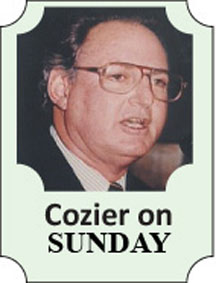BY its very nature, there are few more thankless jobs than that of the West Indies cricket selectors.
In times of decline, as over the past two decades, when their options are limited and defeat is habitual, their judgment, even their motives, are questioned by a disgruntled public driven by insularity, by the media, by the players and their association, by prominent politicians and, yes, by board members who appoint them.
They are often subjected to virulent, open abuse, as Sir Wes Hall once noted when accosted by a young boy and his father in an airport lounge during his stint on the panel.
So, without getting overly sympathetic, spare a thought for Clyde Butts, Courtney Browne and Robert Haynes who have to deal with the further complications caused by the addition of Twenty20 to the international schedule and of the regular unavailability of their best players, either on West Indies duty, lured by the five and six figure contracts of domestic Twenty20 leagues or, at their request, given time off to “rest”.
The present situation typifies their confusion.
In the space of a couple of months, they have had to pick squads for all three formats – the 50-overs-an-innings ODIs and one-off Twenty20 in Australia and the three ODIs, twoTwenty20s and two Tests against Zimbabwe; their next assignment is to choose 15 for the ICC Champions Trophy in England in June.
The regional tournament preceding the Australian trip was the Twenty20, hardly the proper preparation for players or guide for selectors for an ODI series. The 15 were chosen even before that started.

Clearly, standards were compromised.
Trinidad & Tobago were without the Bravo brothers, Kieron Pollard and Sunil Narine; Barbados had to reconstitute their fast attack in the absence of Kemar Roach, Tino Best and Jason Holder (in Australia) and Fidel Edwards (in Bangladesh); Chris Gayle, Andre Russell and Marlon Samuels (injured in the preceding Big Bash tournament) were missing for Jamaica.
Given the first-class status accorded the matches, much of it was counterfeit cricket. It left the selectors to assess the true value of performances.
What credibility would they attach, for instance, to Devon Smith’s prolific returns in another low-scoring season (139 and 106 not out for Windwards against CCC, 99 against Trinidad & Tobago in the four-day tournament, 110 not out against Guyana in the Super50). Aged 31 and with 33 Tests (average24.71) and 42 ODIs (average 26.68) behind him, does such form press for his return to the West Indies team?
Or are Kirk Edwards’ 120 against Guyana and 109 against CCC enough for his reinstatement to the team from which he was dropped in England last year, following two centuries, five half-centuries and an average of 39.11 in his nine Tests?
And what about Nikita Miller’s 10 wickets for Jamaica against Barbados that, following his 42 wickets in 2012, reinforced his status as the leading left-arm spinner at regional level?
Or the advance of Chris Jordan, 24, a bowler of lively pace and good control with 15 wickets in Barbados’ first three matches, and an outstanding fielder?
And so on and so forth.
The same questions could be asked of returns in the current series against Zimbabwe, an inexperienced team at the bottom of the ICC rankings further diminished by lack of competition (next week’s Test is their first since one in New Zealand more than a year ago).
Ramnaresh Sarwan is the most obvious case in point.
A classy batsman with the background of a dozen years in international cricket and an average over 40 in both Tests and ODIs, he had been out of the West Indies team for 18 months for a variety of complicated reasons, most involving his relationship with coach Ottis Gibson and former West Indies Cricket Board (WICB) chief executive Ernest Hilaire.
He was fast-tracked back for the ODIs in Australia when it was apparent from his travails in the regional Twenty20 that he was not yet ready. He predictably struggled (scores of 0, 0 and 12 before he was dropped) but, given another opportunity on return home, he opened the batting and stroked 120 unbeaten against Zimbabwe in the second ODI.
He might not have been in the eleven hadn’t Chris Gayle been given time off and Johnson Charles tweaked a hamstring in compiling his 130 in the first match.
So the selectors find themselves in a quandary over whether this was enough to merit Sarwan’s return to the 11 for the two Tests against Zimbabwe and then for the Champions Trophy.
Gayle will be back for both, Charles, the most improved batsman in West Indies cricket, at least for the latter. Room has to be made in the Tests and the Champions Trophy for Marlon Samuels, who has given the assurance that the eye injury he sustained in the Big Bash in Australia in January is fully healed, and in the Tests for Shivnarine Chanderpaul.
That would settle five of the first six in the order for the Tests (Gayle, Kieron Powell, Darren Bravo, Samuels and Chanderpaul) with one batting place to be filled. The choice seems to lie between Sarwan, Narsingh Deonarine and Kieron Pollard.
Given his ability to destroy bowling such as Zimbabwe have on offer and the maturity he has brought to his batting over the past year (with two hundreds against Australia and one against India), Pollard deserves the chance to show what he can achieve in unrestricted, red ball cricket. If he doesn’t get it now, after 75 ODIs and 33 Twenty20 Internationals, he never will.
It is up to the selectors and they know they are likely to be pilloried whoever they pick.





